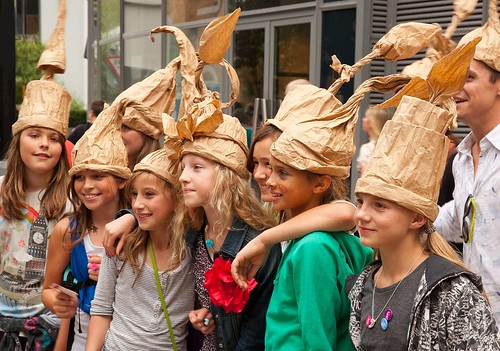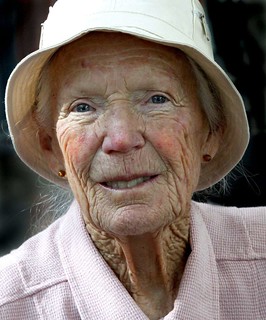
• The Lady •
Classic Rembrandt Lighting in a modern street portrait
Click image to view large
• The Lady • by Netkonnexion, on Flickr![]()
There is a beauty in simplicity.
I love to make street portraits, simple characterisations of people in their real lives. The street photographer thrives on the capture of the moment in someone’s life that just says a little about who they are… a moment in the life of a person you will never know. In this post I am going to look at how best to capture a street portrait.
1. Eye to eye
Out there on the street you a part of the scene – creating a momentary rapport with your street subjects. People like to communicate. And, they like to see communication. When you take a street portrait try to get your subject looking at you. If they are, they are communicating with you. The viewer of your photograph will be a part of that correspondence too. It will pull them in. Work at the eye level of your subject. Explore their faces through their eyes. Your capture will have much more power. If you are able to capture them looking in your direction, make sure the eyes are in focus too. This is good advice for any photograph, but it is critical for portraits. If the eyes are out of focus any appearance of communication will be lost.
2. Understanding the background
Every subject exists in some sort of environment. However, street portraits don’t allow much control over the background. Sometimes that can ruin your shot. A street portrait is about your subject. If there is too much going on around your subject then it can be a distraction. It takes the viewers attention away from the person you are showing them. When you are doing street portraits you can control the background in two ways – capitalise on it or get rid of it. If it is interesting, not too distracting, and puts your shot in context, then go for a deep depth of field (say, f11). That way you show your subject in the full light of the city environment. On the other hand if the background is complicated, distracting, or just uninteresting – go for a wide aperture and shallow depth of field. If your subject is away from the background your subject will stand out leaving the background out of focus.
3. The other people round about
If your subject is a part of a group then include the group. However, if they are not in a group portrait the other people round about can add to the shot or create a distraction. Try to make your shot pick out your subject or the group they are in. If you are trying to do a street portrait then your concentration should be on the subject you are trying to show. If you are more interested in your subject with their group then the relationship is important. Fix on that and bring it out.
The point of street photography is to show something coherent. If what you show is simply the chaos of a street scene, most of the time the impact will be lost in the chaos. When there is more than one person in your scene you need to bring out relationships, coherence or some sort of point that makes the shot interesting. There is nothing wrong with capturing a group of people as long as the capture has a point. Tell a story, bring out the meaning.

• Paper hats •
Pulling a group portrait together requires a coherence, collective story or central interest to the shot.
Click image to view large
• Paper hats • By Netkonnexion on Flickr ![]()
4. In the best possible light
The character of the light is one of the most important aspects of the shot. There is no single rule for lighting but it certainly helps to have an idea about the basics. In the photo above, “The Lady”, you will notice the triangular patch of light on her left cheek. This is a portrait lighting situation called “the Rembrandt” after the famous renaissance painter who pioneered this lighting. The form of the light/shadow helps show off the shape of the face and highlights the cheeks beautifully. In this case her eyelashes cast an interesting shadow and add character to the shot too.
When you are taking street portraits it helps to know about basic portrait lighting. The light and shadow on your subjects face is important. The wrong light can affect the form and shape of your subjects face, be unflattering or even create odd contrasts or miss-shape the face. It can certainly create a distraction if it is wrong. If you want to know more about how to light the face for portraits then check “Simple positions for classic portrait work”. It is the face that gives the most character to your subject. A beautifully photographed face is the foundation to a great shot.
5. Shoot many shots
No one should just be machine-gunning shots. Look for great shots and take them with care and consideration. On the other hand, you really want to make your trip worthwhile. Concentrate on bringing out some of the points above, but make sure you take lots of shots. Street photography is an uncontrolled situation. To ensure you get the best out of the subjects you see you will need to follow up on as many interesting points as you can. Things change fast – you may not get a second chance. Look, study, consider, frame, shoot – a working sequence of steps for a great shot. If you keep spotting interesting things… do your best to capture them.
 Photokonnexion tips by email
Photokonnexion tips by emailIf you enjoyed this article please sign up for our
daily email service.
Find out more…
Start Photokonnexion email subscription now!
Photokonnexion Photographic Glossary – Definitions and articles.
Light and Lighting – Resource pages on Photokonnexion
Street Photography Resources
“Simple positions for classic portrait work”
We would love to have your articles or tips posted on our site.
Find out more…
Write for Photokonnexion.



